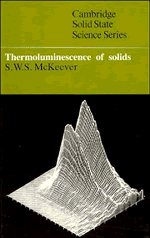Book contents
- Frontmatter
- Contents
- Preface
- 1 Introduction
- 2 Theoretical background
- 3 Thermoluminescence analysis
- 4 Additional factors governing thermoluminescence
- 5 Defects and thermoluminescence
- 6 Thermoluminescence dosimetry (TLD)
- 7 Thermoluminescence dating
- 8 Geological applications
- 9 Instrumentation
- Appendix A Minerals
- Appendix B Commercial thermoluminescence systems
- References
- Index
8 - Geological applications
Published online by Cambridge University Press: 04 April 2011
- Frontmatter
- Contents
- Preface
- 1 Introduction
- 2 Theoretical background
- 3 Thermoluminescence analysis
- 4 Additional factors governing thermoluminescence
- 5 Defects and thermoluminescence
- 6 Thermoluminescence dosimetry (TLD)
- 7 Thermoluminescence dating
- 8 Geological applications
- 9 Instrumentation
- Appendix A Minerals
- Appendix B Commercial thermoluminescence systems
- References
- Index
Summary
General
As noted in chapter 1, the use of thermoluminescence in geology was one of the earliest applications of the phenomenon and both terrestrial and extraterrestrial (meteorite) rocks were examined for thermoluminescence before the beginning of the twentieth century. The natural thermoluminescence from a geological specimen depends, for its character and intensity, not just upon the nature of the phosphors involved, but also upon the dose received in nature, the period over which this dose is delivered, and the temperatures) experienced by the specimen during this time. Thus, the natural thermoluminescence contains locked within it information relating to the detailed thermal and radiation histories of the samples and unlocking this information has been the main goal of research into the natural glow from geological samples. Clearly the three parameters alluded to above, namely, dose, time and temperature, cannot be determined from a single measurement and the requisite detailed studies are not trivial. Information on kinetics, emission spectra, mineral types, radioactivity, dose response, sensitization, etc. has to be gathered if premature judgements are to be avoided.
A different ‘family’ of measurements which are often reported concerns the ‘artificial’ thermoluminescence, namely, that induced by a known dose given in a controlled environment in the laboratory. Measurements of this nature are usually carried out to derive data on the basic properties of the luminescent phosphor. Such data can be used to infer information about the source origin of the mineral, and, for example, its degree of metamorphism, etc.
- Type
- Chapter
- Information
- Thermoluminescence of Solids , pp. 293 - 322Publisher: Cambridge University PressPrint publication year: 1985



